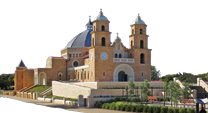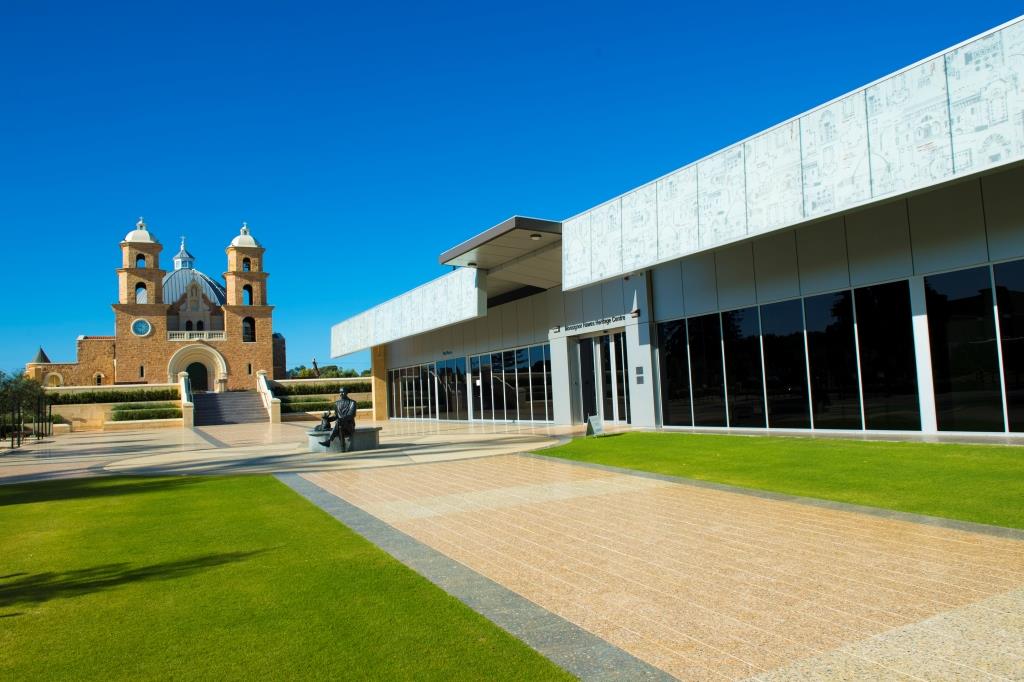Christmas Season
|
THE GERALDTON BELLS RING FOR THE FIRST TIME The Geraldton Bells pealed out sonorously over the Greater City of Geraldton for the first time as part of a Solemn Evening Prayer service at St Francis Xavier Cathedral on Friday 29 November where they were dedicated by Bishop Michael Morrissey. Since the bells were blessed on Easter Sunday in April this year, they have been carefully lifted into the towers of the Cathedral where they have been attached to steel framing that serves also to strengthen the stone towers. Three of the 27 bells have been hung to swing, including the largest of the bells named “Big Peter” that weighs in at just over 1 tonne. This bell, donated by Mr Laith Reynolds of John Taylor & Co Bell Foundry, was dedicated at Mr Reynold’s request to Monsignor John Cyril Hawes, whose name is inscribed on the front of the bell. THE FIRST BELLS OF ST FRANCIS XAVIER CATHEDRAL On 12 August 1923, Monsignor Hawes was present together with Fr Prendergast on the Cathedral balcony for the dedication of the first bell which he named “Great Peter”. The Geraldton Guardian (14 August 1923) reported that “A number of the congregation ascended to the outer balcony between the two towers of the west front, the rest viewing the ceremony from the terrace below.” The Guardian went on to say that “It is probably the largest bell in W.A., being four feet, six inches, in diameter. The bell weighs one and a quarter tons, and with its mountings, a total of one and three-quarter tons. It was cast by the C.S. Bell Co., of Hillsbro, Ohio, USA, being made of a special modern American bell metal, which contains a large proportion of steel in addition to the usual alloy of tin and copper.” |
|
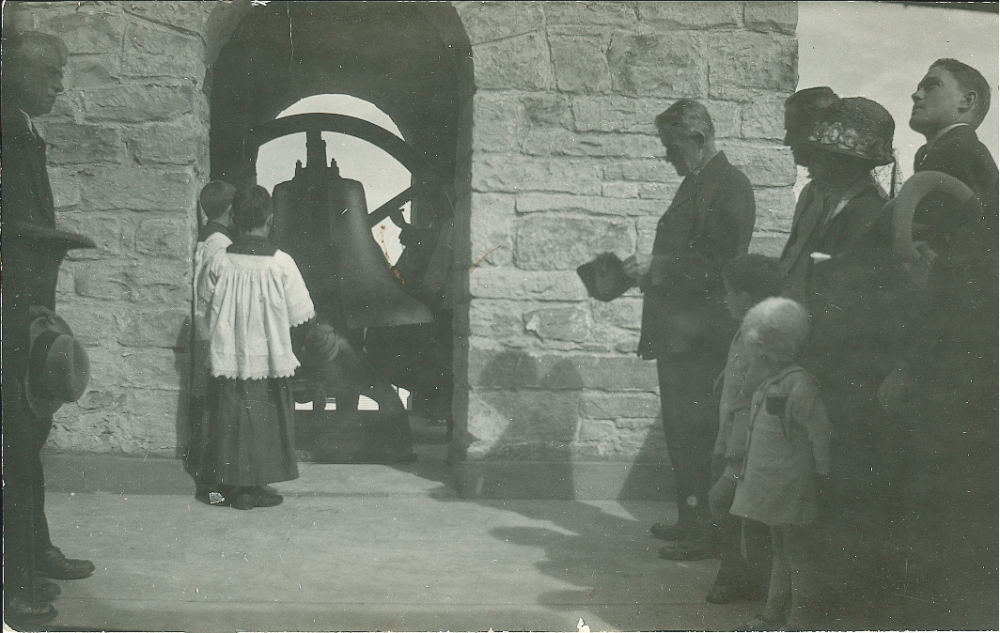 |
|
|
The Geraldton Guardian reported on 13 October 1931 that “During the next few weeks residents will miss the periodical tolling of the large bell at St Francis Xavier Cathedral, the bell having sustained an eighteen-inch crack on one side . . .” The bell was repaired but it cracked again around the time of World War II and was removed from the Cathedral tower and left to decay where the Statue of Our Lady is located near the Divine Mercy Shrine. Great Peter is now in private ownership. Maybe one day it will be re-acquired by the Diocese to be placed in the Cathedral precinct and help tell the story of the Cathedral’s bells over the history of the building. There is one other bell located in the very top compartment in the SW tower of the Cathedral that has been part of the history of St Francis Xavier Cathedral and indeed of the original St Francis Xavier Church in Geraldton that was located in the vicinity of the roundabout at the junction of Phelp Street and Chapman Road. This bell dates back to 1870 and was made by J Murphy Founder, Dublin. An almost identical bell is located at St Peter’s Church in Greenough. It is possible they were obtained by Bishop Griver with the assistance of Fr Gibney who later became Bishop of Perth, when Geraldton and Greenough were part of the Diocese of Perth. |
|
 |
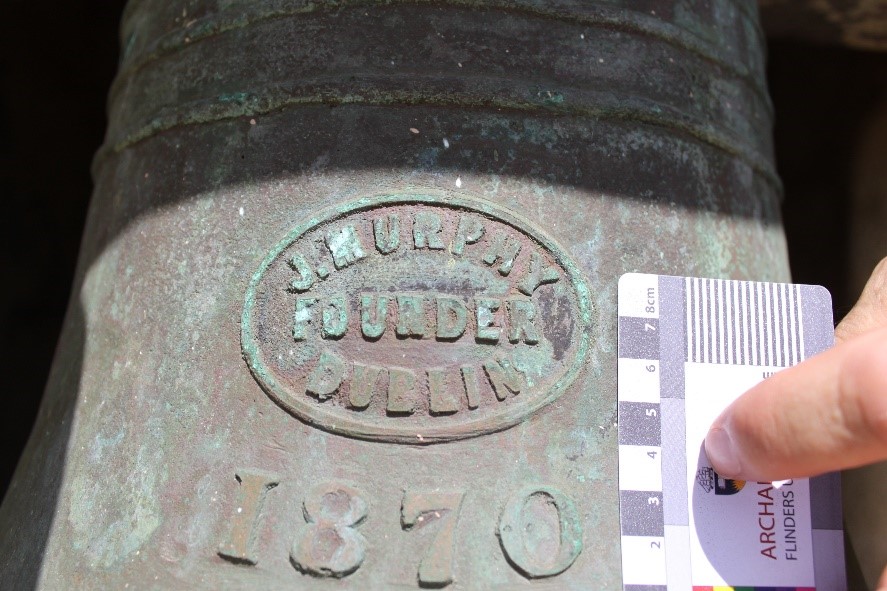 |
|
HOW THE GERALDTON BELLS CAME TO BE Horrified to hear that it was intended to install electronic “bells” (amplified bell sounds through speakers) for the Cathedral, Fr Robert Cross sought the permission of Bishop Bianchini to fund raise and search for a real set of bells. On 9 July 2014, Fr Cross wrote to Mr Laith Reynolds asking his assistance to purchase and install a full set of bells for the Cathedral. It was decided to see if there was a second hand set of bells available somewhere in England and in this pursuit, eight ancient bells were found and obtained from the Church of St Peter and St Paul, Godalming, England. The metal in some of the Godalming bells dates to the 12th century having been recast several times over the past 800 years. The last recasting of some of the Godalming bells occurred in 1746, 273 years ago. With the decision to proceed to obtain the bells, Mrs Gerry Eastman and Fr Robert Cross set about finding donors for the bells and raising funds for the installation of the bells. Such was the public interest in the bells and the number of people willing to donate a bell to memorialise their family, group or deceased family members, a decision was made to augment the Godalming bells with a further 19 bells to form a 27 bell carillon, 3 bells of which have been hung in a manner to allow them to swing. All the bells were paid for by generous donations with names of donors inscribed on the bells for perpetuity. Unlike “Great Peter”, the 27 bells of the carillon now installed in the west towers of St Francis Xavier Cathedral are made of none of the “special modern American bell metal” reported in the Sower of 1923, but of strong time tested English bell metal, a copper and tin alloy, and should ring out over the Greater City of Geraldton for centuries to come in memory of their generous donors. |
|
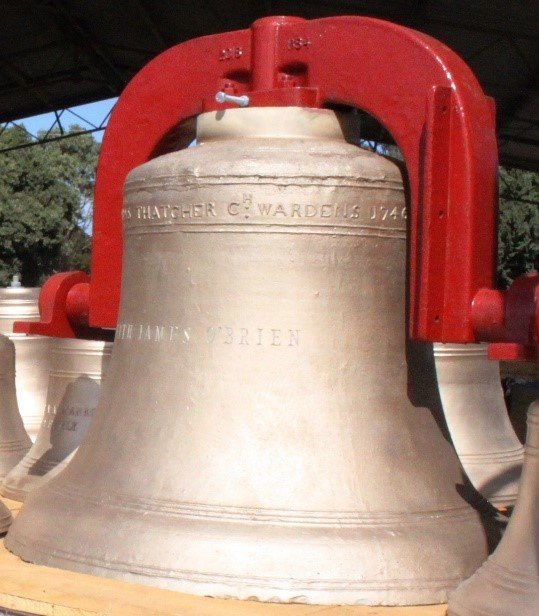 |
|
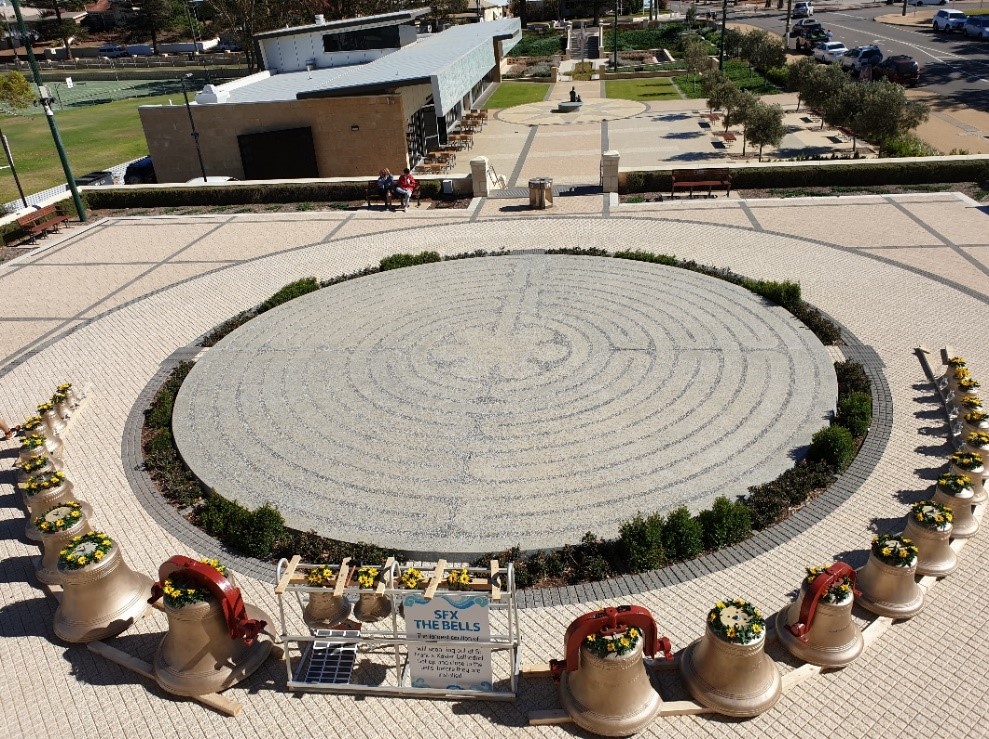 |
|
|
The donors of the Geraldton bells are: |
|
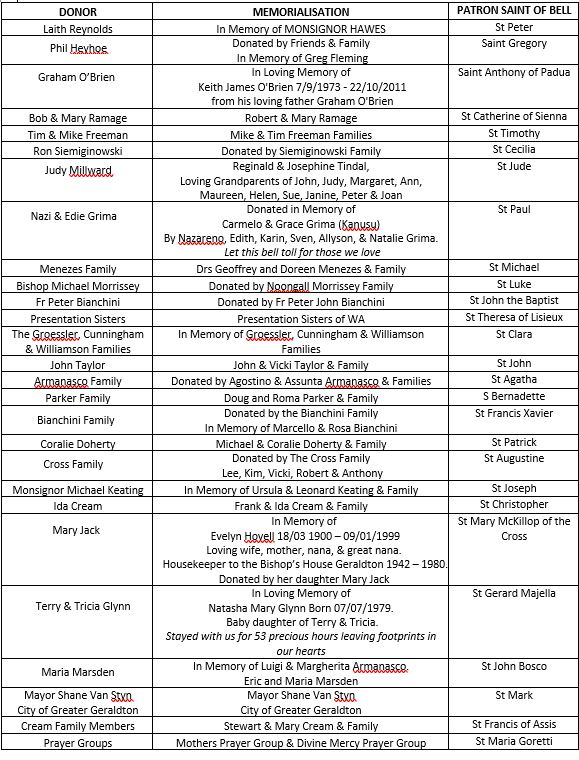 |
|
|
THE DEDICATION AND FIRST RINGING OF THE GERALDTON BELLS As mentioned, on Friday 29 November 2019, around 300 people gathered in St Francis Xavier Cathedral, representing the donors of the bells, parishioners and the wider community of Geraldton to take part in dedication and first ringing of the Geraldton bells. The occasion was presided over by Bishop Michael Morrissey together with the Bishop Emeritus Justin Bianchini and the Cathedral Precinct Project Patron Archbishop Emeritus Barry Hickey. Before Solemn Sung Evening Prayer (Vespers) commenced, with presider being Fr Robert Cross and the cantor Fr Gerard Totanes, St Mary’s Cathedral Perth organist, Jacinta Jakovcevic, played the newly installed bell carillon in conjunction with the Cathedral’s pipe organ. The pieces played were Praeludium in g minor BuxWV 149 - Dietrich Buxtehude (1637 – 1707) & Toccata in G major BuxWV 165 - Dietrich Buxtehude (1637 – 1707). |
|
 |
|
|
A feature of the Vespers was the chanting of the Litany of Saints, with the composition of the Litany containing the patron saint of each of the bells and the bell of the respective saint sounded after the chanting of each saint’s name. The patron saints for the bells were chosen by the donors. At the conclusion of the litany, Bishop Morrissey dedicated the bells with a prayer and blessing and after the concluding prayer and blessing of Solemn Vespers the three swinging bells sounded the first ringing of the Geraldton Bells with their joyful harmony filling the Cathedral and the Greater City of Geraldton. After the first official ringing of the bells, Mr Laith Reynolds told the story of the Geraldton bells and outlined some of the unique features of the Geraldton Bells, including the fact that they are the largest carillon of bells in any Church in Australia and to his knowledge one of only two genuine carillons of bells linked directly to the console of a pipe organ. |
|
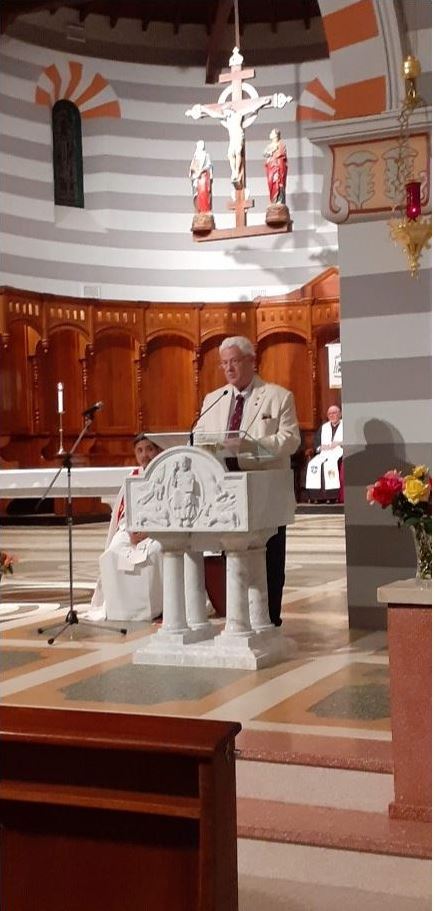 |
|
|
Bishop Michael Morrissey then thanked everyone for their attendance and announced the launch of a final fund raising appeal for the Cathedral Precinct Project due to unforeseen costs to repair damage done to the Cathedral’s external electric cabling by corellas and the need to strengthen the security screening of the Cathedral’s precious stained glass windows from future vandalism given that only weeks before a vandalism attack on the Cathedral’s windows had cost $42,000 to repair. The Cathedral Precinct Project Chair, Mr Bernard Brown supported and gave every encouragement to all to generously respond to this last push to raise funds announced by the Bishop given the damage done to the Cathedral by “pests”, namely the corellas and vandals, was unforeseen and beyond the committee’s ability to control. In fact, Mr Brown pointed out that to have a $100,000 deficit after a $9.6 million project is an exceptional achievement. After the speeches, MS Jacinta Jakovcevic played a “mini concert” of 2 pieces on the organ and the bell carillon, namely Jesu Joy of Man’s Desiring – Johann Sebastian Bach (1685 – 1750) and Violin Concerto G major (Vivaldi) BWV 592 – Johann Sebastian Bach (1685 – 1750). These were rapturously applauded by all present. To conclude the official proceedings, Jacinta performed an amazing ethereal atmospheric rendition of Carillon de Westminster – Louis Vierne (1870 – 1937) that enchanted all present. |
|
The archives of the Diocese of Geraldton is a private Archive.
Personal access to the archives is not available.
Archival search requests (e.g. genealogy research, historical events, historical places) are ordinarily not possible due to staff and time constraints. In exceptional circumstances (as determined by the Diocesan Archivist) a search can be undertaken with the following fees applying:
Other Archival Search Requests Fee (incl. GST):
- Search request: $33 per search not exceeding one hour. The first $33 must be paid when submitting your 'Archives Search Request Form' (below).
- If the search is to extend beyond one hour, we will contact you to confirm if you wish to make a further payment.
Sacramental records search requests can be made under the following conditions:
A) Access to sacramental records created 75 years prior to January 1 of the current year is unrestricted.
B) Access to sacramental records created within the last 75 years is granted only to the individual to whom the record pertains or to a person who has legal responsibility for the individual (e.g. the parent of a minor child). ID is required. Legal documents demonstrating legal responsibility are required in the case of persons claiming legal responsibility for an individual whose sacramental records are being sought..
C) Official copies of sacramental records are issued only to the individual requesting his or her record or to a person who has legal responsibility for the individual (e.g. the parent of a minor child).
Archival Sacramental Search Fee (incl. GST):
- Search request: $33 per search not exceeding one hour. The first $33 must be paid when submitting your 'Archives Search Request Form' (below).
- If the search is to extend beyond one hour, we will contact you to confirm if you wish to make a further payment.
PLEASE NOTE: No charges are incurred for sacramental record searches relating to persons requesting their own sacramental records for the purpose of receiving other Sacraments (e.g. Marriage, First Communion and Confirmation) or to be enrolled in a Catholic school.
Enquiries:
Fr Robert Cross
+61 8 9921 3221
This email address is being protected from spambots. You need JavaScript enabled to view it.
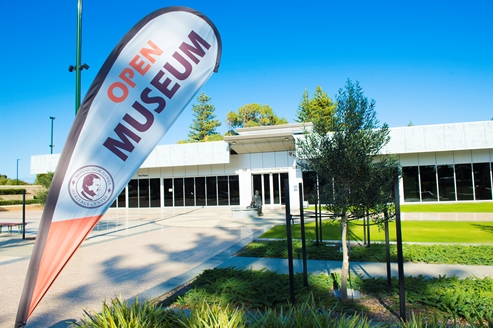
Monsignor Hawes Heritage Centre
56 Cathedral Avenue Geraldton WA
Open daily 10am - 4pm
'Visit Monsignor Hawes Heritage Website'
"A Poem in Stone"
 The St Francis Xavier Cathedral was designed by Monsignor Hawes (Priest and Architect), who arrived in Geraldton as a parish priest in 1915 - the building is generally regarded as one of his finest works.
The St Francis Xavier Cathedral was designed by Monsignor Hawes (Priest and Architect), who arrived in Geraldton as a parish priest in 1915 - the building is generally regarded as one of his finest works.
The foundation stone was laid in 1916 and the building completed in 1938.
General Description
 The work of building the Cathedral began on June 20th, 1916; the laying of the western portion was then started. The cornerstone forms a historical link with the first catholic church built in Geraldton - old St. Francis Xavier's down by the coast built in 1870 by Father LeCaille at the north end of the township of Geraldton and later pulled down to make room for railway extensions.
The work of building the Cathedral began on June 20th, 1916; the laying of the western portion was then started. The cornerstone forms a historical link with the first catholic church built in Geraldton - old St. Francis Xavier's down by the coast built in 1870 by Father LeCaille at the north end of the township of Geraldton and later pulled down to make room for railway extensions.
The section completed in this first stage was the Twin Towers and the Nave. The unfinished walls of the central octagon and south transept were covered by a temporary roof of wood and corrugated iron.
The towers were later crowned with their domed roofs but little more was done until 1926 when the crypt was extended eastwards and the sanctuary finished above it. The sanctury was then linked to the Nave by a temporary wood and iron structure. During the ensuing year the Sisters Chapel was built out on the south side of the High Altar. Nothing more was done for ten years. In August 1937 the final completion of the whole building was taken in hand by Bishop O'Collins.The completed building was opened on August 28th, 1938.
In the design of the Cathedral the aim of the Architect was to avoid any slavish imitation of past 'Styles'; but to give character and expression to the building by austere simplicity of design and by the harmonious proportions of the several parts. All useless ornamentaion and elaboration that would lead to extra expense were rigidly avoided. There are no traceried windows, pinnacles or carved decorations. Solidity and massiveness were chosen rather than pettiness and eligance.
In as far as the design follows the characteristics of any "style" it may be said to be after the round-arched classical style of ancient Rome; with a leaning to the features sometimes of the Romanesque or Norman (11th Century) variation of that style, sometimes of the Renaissance (17th Century) development of the same.
 |
 |
 |
 |
 |
 |
The twin towers of the west are very much like the Californian Mission Church in Santa Barbara and the large central dome over the crossing has a fleeting resemblance to Brunellesci's famous Cupola in Florence.
The first thing that strikes most people about the interior of the building is its colouring - arranged in stripes of grey with orange markings. It resembles the fashion of "many churches and cathedrals of Italy, such as Sienna and Orvieto. Visitors who have visited the Great Mosque at El Cordoba, Spain also remark on the similarity of interior design, albeit on a much smaller scale, and the colour scheme.


